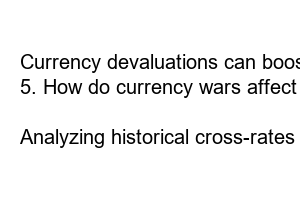과거 환율조회
Title: Past Exchange Rate Inquiry: A Comprehensive Overview
Introduction:
Welcome to our blog post, where we will delve into the intriguing world of past exchange rate inquiry. Understanding the historical dynamics of exchange rates can provide valuable insights and help make informed decisions in the present. Join us as we explore the factors that shaped past exchange rates and their significance today.
1. The Relevance of Historical Exchange Rates:
Exploring historical exchange rates offers valuable perspectives on currency fluctuations, economic trends, and global events that have shaped the financial landscape. Discover how examining the past can empower individuals and businesses to navigate the dynamics of exchange rates in the present.
2. Factors Influencing Exchange Rates:
Explore the primary factors that influence exchange rates, such as interest rates, inflation, political stability, and market speculation. Uncovering the interplay of these elements will provide a deeper understanding of how exchange rates have been historically affected and how they may continue to fluctuate in the future.
3. Noteworthy Historical Exchange Rate Movements:
Uncover significant historical exchange rate movements, including the collapse of the Bretton Woods system, the adoption of the euro, and the Asian financial crisis. By examining these past events, one can grasp the impact of economic, political, and social phenomena on exchange rates.
4. Currency Pegs and Devaluations:
Discover the historical instances where countries pegged their currencies to external benchmarks, like the gold standard or other major currencies. We will explore how these pegs have influenced exchange rates, the reasons behind currency devaluations, and their implications for global trade.
5. Lessons from Past Currency Wars:
Dive into the history of currency wars, where nations engage in competitive devaluations to gain an advantage in the international market. By understanding past instances of currency wars, we can gain insights into the risks and benefits associated with such aggressive exchange rate policies.
6. Examining Historical Cross-Rates:
Uncover historical cross-exchange rates, where two currencies are compared against a third currency. Analyzing these cross-rates can offer a broader perspective on the relative strength or weakness of currencies, helping both individuals and businesses make informed decisions in currency trading or foreign investments.
7. Forecasting Exchange Rates:
Learn about the methods used to forecast exchange rates, including fundamental analysis, technical analysis, and economic indicators. We will discuss the limitations of exchange rate forecasting and how historical patterns can be utilized to assess potential future movements.
Summary:
Exploring past exchange rates is not just a historical exercise but a valuable tool for understanding the present financial landscape. By grasping the factors influencing exchange rates, analyzing historical patterns, and learning from significant events, individuals and businesses can make more informed decisions regarding currency transactions, investments, and trade. Embrace the past to navigate the complexities of the present and future exchange rate fluctuations.
FAQs:
1. Can I predict future exchange rates based on historical data?
While historical data can provide insights into exchange rate patterns, predicting future rates with absolute accuracy is challenging. However, analyzing historical trends and considering relevant economic factors can help inform your expectations.
2. Is historical exchange rate analysis only relevant for businesses?
No, historical exchange rate analysis can benefit individuals, investors, or anyone involved in international transactions. It provides a broader understanding of currency fluctuations and their impact on personal finances and investments.
3. Are currency pegs still relevant in today’s global economy?
Though less prevalent today, currency pegs can still be observed in some countries. However, owing to the increased globalization and flexible exchange rate regimes, the use of currency pegs has diminished.
4. What are the risks associated with currency devaluations?
Currency devaluations can boost a country’s exports, but they also come with certain risks, such as inflation and a potential negative impact on foreign investments. Careful consideration is necessary when implementing such policies.
5. How do currency wars affect global economies?
Currency wars can lead to increased volatility in international markets, disrupt trade flows, and create competitive disadvantages for nations that are not actively engaged. Cooperation among countries is crucial to avoid escalating tensions.
6. Can analyzing cross-rates help identify arbitrage opportunities?
Analyzing historical cross-rates can reveal discrepancies in currency valuations, potentially indicating arbitrage opportunities. However, it is important to consider transaction costs, market liquidity, and geopolitical factors before engaging in such activities.

